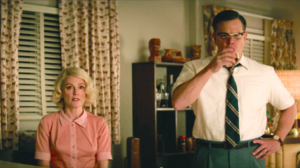Suburbicon
Posted on October 26, 2017 at 5:30 pm
C| Lowest Recommended Age: | Mature High Schooler |
| MPAA Rating: | Rated R for violence, language and some sexuality |
| Profanity: | Strong language including racist epithets |
| Alcohol/ Drugs: | Drinking, smoking |
| Violence/ Scariness: | Intense and graphic violence including multiple murders, many grisly and disturbing images |
| Diversity Issues: | A theme of the movie |
| Date Released to Theaters: | October 27, 2017 |
| Date Released to DVD: | February 5, 2018 |

“Suburbicon” is like a beautifully gift-wrapped box that turns out to be empty or a shaggy-dog story that entices you with promising details and then it is supposed to be funny that there’s no ending. A script by the Coen brothers that plays like a correctly discarded early draft of “Fargo” has been tweaked by George Clooney and Grant Heslov, a long way from their brilliant “Good Night and Good Luck,” and directed by Clooney. Even full-on stars Matt Damon and Julianne Moore (in a dual role!) cannot outshine the real star of the movie, the ironic air-quoting production design. The only member of the cast who makes any real impression is Oscar Isaac as an insurance investigator who calls himself a “professional skeptic” and provides a too-brief jolt of energy and interest in a movie that is otherwise way to amused by itself.
“Suburbicon” begins with a cute commercial for a idealized 1950’s planned community that ends with a cheery, “The only thing missing is YOU!” It looks like Walt Disney, Norman Rockwell, Dick and Jane readers, and all those sitcoms with cheery moms who vacuum in pearls and full makeup got together in all of their mid-century, postwar, consumerist, idealized, sanitized, and claustrophobically conformist and Everyone is welcome, it tells us, whether you’re from New York, Ohio, or Mississippi. But all of the people in the ad are white and all of the people in Suburbicon are white….until the Myers family moves in. They are black. This is a pointed reference to the real-life experience of the real-life black Myers family who moved to the conformist, consumerist planned community of Levittown in in 1957, resulting in constant harassment, threats, and a three-week-long riot, which the family endured with grace and patience.
That goes on here, as we see Mrs. Myers (Karimah Westbrook) told by the manager at the grocery that for her the price of a gallon of milk is $20, neighbors build a fence around their yard, and a crowd gathers outside their house, taunting them and setting their car on fire.
But that is not what the movie is about. The movie is mostly about what is going on next door, where armed intruders tie up and chloroform a family, Gardner Lodge (Matt Damon), his wife Rose, who is confined to a wheelchair (Julianne Moore), her sister Maggie (more Moore), and his young son, Nick (an excellent Noah Jupe). Rose dies in the attack and Maggie moves into the house to help take care of Nick and Gardner.
And then things get really tangled. They just don’t get interesting. The production design and camera work are excellent, but what actually happens on screen is just a pointless escalation of deranged violence with cutaways to the poor Myers family to show how dumb it is that the neighbors are terrified of the black family while the white family is what should terrify them. But just making that point as people run around doing terrible things to each other and to a child is neither insightful nor effective.
Parents should know that this film is filled with horrifying violence, some of it very explicit and bloody. There are many murders and other bad behavior. A child is in peril, and he witnesses violence, sex, and bad behavior by the adults in his life. Virulent racism is a theme in the movie and characters use strong language including racist epithets.
Family discussion: Ask members of your family for their memories of the 1950’s. Why did the Myers family stay?
If you like this, try: “Fargo,” “Blood Simple,” “Confessions of a Dangerous Mind,” and “Serial Mom”
